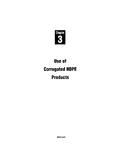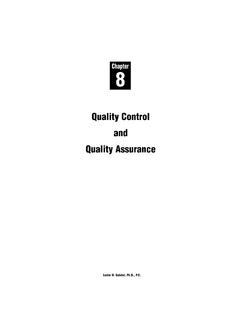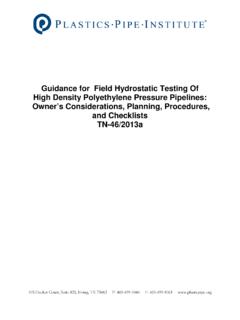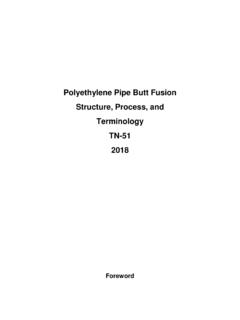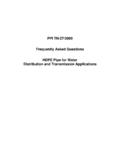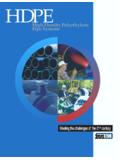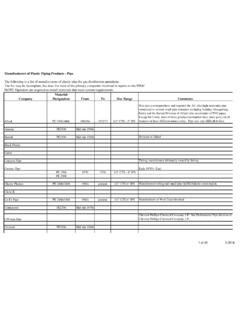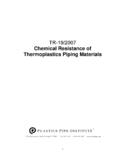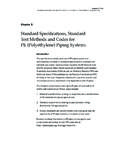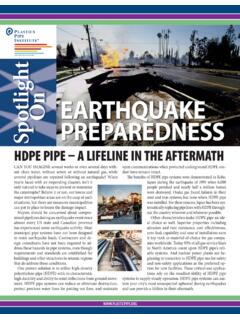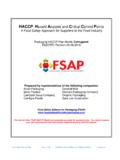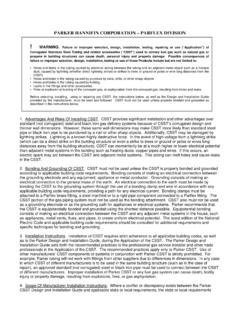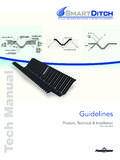Transcription of Chapter 6: Installation and Construction - Conduit Division
1 6 ChapterInstallationandConstructionLester H. Gabriel, , 6: Installation AND CONSTRUCTIONThis Chapter provides information on the handling and Installation of corrugatedpolyethylene pipe and fittings in non-pressure applications including most sewers,culverts and subdrainage systems. All types of pipe, regardless of material, must beinstalled as specified to perform as Department of Labor, Occupational Safety and Health Administration (OSHA), Safety and Health Regulations for Construction requires observance of its safety andother guidelines during all phases of Construction including foundation preparation,excavation, pipe handling, assembly and backfilling.
2 Stricter requirements may berequired in some states and local guidelines for the Installation of corrugated polyethylene pipe are located in the following standards: ASTM D 2321 Standard Practice for Underground Installation of Thermoplastic Pipe for Sewers and Other Gravity-Flow Applications CAN/CSA Recommended Practice for the Installation of Thermoplastic Drain, Storm and Sewer Pipe and Fittings AASHTO Section 30 Thermoplastic PipeImportance of Good Installation PracticeThe structural design of a buried pipeline presumes the response to loads of a pipe/soil composite structure.
3 Attention to detail on the part of the contractor, transporterand yard handler is essential to insure proper performance. Proper dimensional controls of trench excavation, pipe laying and pipe joining are essential to the successof a project. Correct selection and compaction of the soils composing the pipe/soilenvelope are likely to dominate the structural performance of both pipe and soil. The desired constant pressure around the pipe and uniform support of the pipe in the longitudinal direction cannot be achieved in the absence of good D 2321, AASHTO Section 30 and CAN/CSA define good practicesfor the Installation of thermoplastic pipe.
4 Each recommends proper techniques fortrench excavation, placement, bedding and backfill to assure the pipe performs wellduring its full service life. AASHTO Section 30 is narrowly focused on gravity flowhighway and airport drainage pipelines under pavements subjected to heavy wheelloads. Shallow burial is a major consideration. ASTM D 2321 is broadly focused onthe general class of gravity flow pipelines, which include both drainage and sanitaryfacilities. Non-trivial differences exist between the two specifications. Federal, state,county and city governments, or other agencies or organizations of jurisdiction, areINSTALLATION AND CONSTRUCTIONCHAPTER 6: Installation AND Construction responsible for setting the particular governing standards appropriate to the installationof interest.
5 References to specifications in this Chapter are not intended for use in allpipelines at all locations; they are intended only to serve as examples of good practices. Transportation, Handling and StorageThe contractor should conduct an inspection at the time of delivery to verify that the correct products and the expected quantities are received. Pipe walls and corruga-tions, gaskets, pipe ends, couplers or other joints, and accessories should be visuallyinspected for damage such as cuts, gouges, delamination, bulges, flat areas and ovalitythat may have occurred during shipment.
6 Nominal pipe size, manufacturer s name,date code and applicable standards generally are marked on the prevent injury to Construction personnel and damage to pipes, dropping and/orrolling of pipes during unloading and handling should be prevented. Refer to themanufacturer s instructions for unloading of trucks, trailers and railcar 18 in. (450 mm) or less may be hand lifted and placed by two people. Largersizes require mechanical equipment; a minimum of two lifting slings of fabric or plastic, located at third points along the length, is preferred. (Metal chains and cablesare to be avoided.)
7 Equipment such as loading booms or forklifts should not be usedsince they can damage the pipe. Pipe should never be dropped on the ground. Palletized pipe should remain on pallets for jobsite storage. Non-palletized pipe shouldbe stockpiled for temporary storage in a flat debris-free area clear of Construction traffic. Do not remove tie-down straps or bands until the pipes have been secured. Pipes should be stockpiled on level ground and restricted to a stack height no greaterthan 6 ft. (2 m). To prevent rolling, blocking should be provided at approximatelythird points along the length.
8 The removal of any one pipe should not cause shiftingor rolling of any of the remaining pipes. The pipe should be supported along itslength, avoiding concentrated loads along bell ends. Any protective covering of gaskets should remain until the pipe is ready for Installation ; exposed gaskets shouldbe protected from dust and exposure to sunlight. Couplers and fittings should bestored flat to prevent distortion and damage. For pipe with attached bells, a commonstacking method is to alternate the direction of the pipe lengths so that the bells arenot stacked on each other.
9 For smooth interior pipe, nesting smaller pipes inside larger pipes can minimize the storage space. Factory installed gaskets on the spigotmay be protected by positioning them between pipe corrugations. Nesting corrugatedinterior pipe should only be done when the pipe can be easily removed. Extreme summer heat could affect the ovality or shape of some pipes. It is recommended thatproducts be rotated during storage to eliminate such deflection. Chapter 6: Installation AND CONSTRUCTIONT rench ExcavationThe soil envelope of a pipe/soil composite structure will reflect the qualities of thenative materials beyond the trench walls containing the pipe.
10 If the soil stiffnessbeyond the trench wall is stiffer than the expected stiffness of the compacted trenchfill, then the specified trench width is generally governed by that width necessary toinsure the prescribed compaction. For competent in-situ soil, wider than necessarytrench widths are not advised. Should the soil stiffness beyond the trench wall beless stiff and/or readily more compressible than the required trench fill, then thetrench width is often specified by the customer agency or organization to be widerthan usual (see ASTM D 2321). Success of the design of the Installation depends, in part, upon realization of the geotechnical information describing the in-situ soilproperties.
